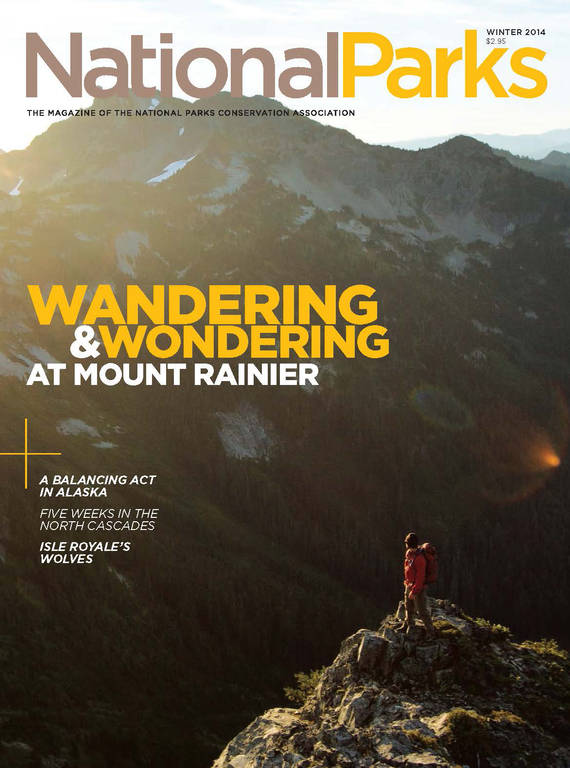Winter 2014
Whatever You Do, Don’t Look Up
Wandering and wondering at the base of North America’s loneliest mountain.
“Don’t look up,” I think. “Don’t look up.” But of course I do. How can I not? The mountain is a magnet, a spot where the sky has gone solid, where light is bent blue by glaciers, and no matter how pretty the season’s last flowers that kaleidoscope the fields, well, they’re not a mountain. Not the 14,411-foot-high Mount Rainier, center of Mount Rainier National Park, and so far from any other mountain that it seems to own the entire sky.
But this time I’m not going to look up. The mountain is only a fraction of the park, so I’ve started to wonder: What can I see, what can I learn and experience if I don’t really look at the mountain—if, for the first time in my life, I come to visit the park and leave without a sore neck from always craning for the view?
SIDE TRIP
It’s not an easy thing to do. When you come into the Pacific Northwest, you’re immediately under the influence of Mount Rainier. Every day, “the mountain”—it doesn’t need a name beyond that anywhere in the state—plays hide and seek with Tacoma and Seattle, with a million people on their way to work and running errands: views of the peaks from behind office buildings, rising around curves on I-5 as much as three hours away, giving drivers something to do besides curse traffic. The mountain even comes through clouds like a speed bump in the sky for planes carrying passengers to Sea-Tac Airport.
Give a local kid a pen and a paper, and this is the mountain he’ll draw: huge, gnarled, streaked by glaciers, and all alone. But what might I draw if I ignore the mountain, don’t give in, don’t look up? What if I just hang out in Paradise, the park’s main visitor area? As you read these words, this area will be buried under snow more than 20 feet deep, but in the lingering summer, Paradise, with a bunch of trails leading to nearby meadows and lakes, is maybe the easiest place in the park to look down. Or at least the place where there’s the most other stuff to look at, like mazes of wildflowers showing off Gauguin’s palette in light breeze.
I take the short paved Alta Vista Trail, where I feel like the tallest living thing in the landscape, walking through a ground of prismatic waves. A friend of mine is a professional flower photographer. Before I knew her, I used to get into a field of flowers and just see patches of color, but she taught me to look closer, at the shapes, at the depths, at the way the arrangement of petals can change the sound of the bees checking for the season’s last pollen. She taught me how to look, so I owe her my full attention to this vision. I sit by the trail, the white wall of Mount Rainier behind me, and get lost in purple and blue. Flowers have their own tides, species blooming and dying, a slow-motion dance with the spectrum; this view will last only one day no matter how I linger, trying to hold it, nose twitching from mingled scents, neck starting to hurt from looking down so long.
Almost overwhelmed with beauty, and I still haven’t looked at the mountain.
In all, Mount Rainier National Park covers 368 square miles, 97 percent of which has been designated wilderness. The mountain may be a landmark to Seattleites—a way to know you’re home in the world—but it demands at least as much respect after its engendered familiarity. Rainier is the most glaciated peak in the Lower 48, with more than two dozen major glaciers, including ice as deep as 700 feet on Carbon Glacier. Few winters go by without local news broadcasts showing pictures of the mountain’s white slopes matching the white clouds and somewhere, hikers who’ve lost the trail.
TRAVEL ESSENTIALS
Under all that ice is the tallest volcano in the continental United States, and it’s still active. For some reason, I find that reassuring. I want that reminder that the world is bigger and more full of power than we truly comprehend, the knowledge that the landscape could drastically change in an instant. Rainier’s last eruption was little more than a burp in 1894, just a couple years before Seattle really started to become a city with the influx of hopeful miners headed to the Klondike. The last time the mountain really blew its top was roughly a thousand years ago. That long spell, though, just means the chances of a Mount St. Helens-style landscape rearrangement continue to increase. Rainier is actually one of the most watched volcanoes around, partly because it seems that its time should be coming around, and partly because of the huge population in what could be the damage zone.
I look up, thinking about my unspoken reason for coming to the park and trying not to get lost in that upward gaze. Not just because looking up is the easy thing to do, the expected thing to do, but because lately my aging body has decided that I’m never really going far uphill under my own power again. Okay, I was never going to climb to the peak of Rainier, but what if now all that’s left are views from where the road goes? Are my limitations a constraint or just a matter of learning to see differently things I’ve never seen before because I’ve been looking somewhere else?
The mountain is keeping its reflection out of the Reflection Lakes when I pass by; some days, the entire world can seem to be upside down here, eagles flying through water. Is that looking up or looking down, I wonder as I get out of the truck at the Grove of the Patriarchs loop trail, just an easy mile and a half through a boggy edge of the Ohanapecosh River. But once again the landscape pulls my eyes up. How can it not? Along this trail are trees pushing 300 feet and a thousand years old. The western red-cedars, which hollow as they age, would have given the local Cowlitz Natives everything they needed for houses, clothes, medicine. They also give other plants a place to grow on the trees’ very flanks, since the Northwest soil is so thin. A big red-cedar can have a hundred other species growing on it.
High in the canopy , the sound of life: birds playing in the wind, twigs and branches rubbing together as if for reassurance, needles falling through the air like piano scales. And so I start thinking about how mountains may raise our eyes, but they themselves flow down—six major rivers peel off Rainier—turning gravity into music.
Sure enough, the Ohanapecosh River lies under the scenery like a tapestry, changing notes with each bend in its course, each glacier-strewn boulder it strikes.
To hear it better, I set out on the Silver Falls Trail out of the campground. It’s easy; the path has almost no rise. It requires only the patience to walk a couple of miles. And the falls reward, coming out of their own mist cloud. Not big—a human-scale waterfall playing the tune of the hill’s slope, the trees coming close themselves as if to listen.
I’ve lived in Washington for the last six years, and I wonder if the fact that Rainier is always there has kept me from ever really seeing it, less than a four-hour drive from my house near the Canadian border, or maybe only two hours from my sister’s Seattle home to this wild moment. Even though this is a mountain landscape, I’ve never really touched the mountain, and yet I’ve still had a perfect day. I sit in the music of the falls, smelling that thick loamy scent of the rainforest, like oxygen is being pumped directly into my heart and lungs, tinged with cedar and fir.
And I am very, very happy.

National Parks
You can read this and other stories about history, nature, culture, art, conservation, travel, science and more in National Parks magazine. Your tax-deductible membership donation of $25 or more entitles…
See more ›And that’s about when I realize what a complete idiot I am. Because even if I haven’t touched the mountain today, how can I deny it’s been touching me? If my malamute-mix Albert were here, somebody to listen, I’d probably go off on a riff now, talk about how what I love most about the park is that the park visits me even when I can’t get to it, that huge snow cone a reminder that dominates the landscape the way a full moon pulls extra light out of the peak glaciers. Many religions teach that the center of the world is a great, lone mountain, the axis mundi, the spot everything revolves around. And Rainier does that for us in the Pacific Northwest, catches us with unexpected glimpses of sheer extravagant beauty, like a tree throwing perfectly red leaves because it knows it’ll never run out.
I didn’t need to come to the mountain today because Rainier always comes to us. Think of the mountain as the park pushing wilderness into the city, instead of cities always encroaching on wilderness.
And so back to Paradise, back to the most famous views of the mountain. That spread cone swirling clouds off its peak, the streaks of glacier and glacier-scraped rock. Most of all, the way it shelters all this: me, the falls, the trees, the flowers not much larger than pinheads but still dressed in their brightest, as if each were an equal star. In one of my favorite things ever written, Gary Snyder’s “Smokey the Bear Sutra,” the poet calls out Rainier as a place of protection, a place where paying attention to the life of the mountain will help us “enter the age of harmony of man and nature,” where we “will always have ripe blackberries to eat and a sunny spot under a pine tree to sit at.”
All the way home, the mountain will play peek-a-boo with my rearview mirror. It really is closer than it appears.
About the author
-
 Edward Readicker-Henderson Contributor
Edward Readicker-Henderson ContributorEdward Readicker-Henderson lives on a lake in Washington State, about 20 minutes from the northernmost views of Mount Rainier.



